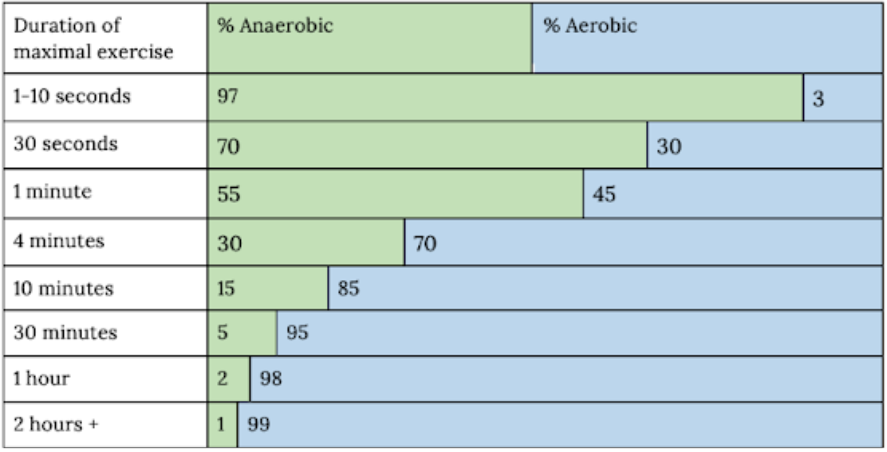We have 3 energy systems that generate energy in the form of ATP in order to perform physical work; the creatine phosphate (or ATP-PC), Lactic (or Glycolytic), and Oxidative (or Aerobic). All three systems work simultaneously during exercise, however each system will become predominant depending on the demands. So it is important to understand the energy demands of your chosen sport, and when and how the energy systems are utilised during exercise, in order to efficiently program intensities and rest in the gym in order to drive the best adaptations from training and best prepare you for performance.
Before we delve into some of the science-y stuff, there are a few important things to note
- Metabolism is the term used to describe these 3 pathways and all the chemical processes involved in taking the food we eat and producing ATP.
- ATP stands for adenosine triphosphate, and you can think of it as the currency of the body. Muscles can only store a small amount of ATP (about 2-3 seconds of work), and so it is rapidly depleted, but very quickly re-generated by our 3 energy systems. So we have an abundance of potential ATP within each cell, and things are set up carefully so that the right amount of ATP will be available when needed. When cells completely run out or deplete ATP – they die..
- The body forms ATP through the conversion of components of food – our macronutrients – carbohydrate (through lactic and oxidative metabolism), and fat (through oxidative metabolism). This is why carbohydrate ingestion is so important to fuel and recover from exercise.
- The Phosphagen and Lactic systems do not utilise oxygen, while the the oxidative system does. The main thing that this affects is how speedy the system is at supplying energy during exercise, as well as the by-products that are formed (hello lactate).
Now, let’s take a look at the three energy system;
The phosphagen system liberates energy for short duration, explosive, powerful movement – think a heavy set of 5 squats or 1RM testing. It is the fastest system because there are only a few uncomplicated chemical reactions to liberate ATP that do not require oxygen. However, this rapid production of ATP comes at a cost, as this pathway is limited to providing energy for only about 10 seconds before fatiguing. The main fuel this system uses is Creatine, which is why supplementation of creatine is extremely useful for strength training performance.
The glycolytic system utilises carbohydrates (glucose or stored glycogen) and predominates short-moderate duration, high intensity exercise – think 800m sprints, or those heavy breathing sets of walking lunges. This pathway does not require oxygen, but does form a by-product called Pyruvate which is converted by the body to lactate. Just quickly, in case you didn’t realise, this lactate is not what causes those nasty side effects such as muscle fatigue and burn that we often associate it with (but we will come back to this a little later).
The oxidative system is our predominant system during lower intensity, sustained exercise – we are talking marathons and day long cycling events. The production rates are not as rapid as our other two systems, but amazingly can provide ATP almost indefinitely. Oxygen is required, and it is powered mostly by fatty acids (as well as glucose and glycogen), and the process to liberate ATP requires a whole cascade of complicated events and chemical processes.
In the table below you can see a breakdown of the relative contribution of the systems according to exercise duration (Remembering that the phosphagen and lactic are anaerobic, and the oxidative being aerobic).

So – that is our 3 energy systems at a glance – up next we are going to talk about the importance of training all 3 energy systems specifically for you. First, we will delve into programming for those with team sport performance goals, then we will address systems training for those looking to improve long distance running or cycling performance. Lastly we will look at systems training for strength-based goals or lifting performance in the gym.